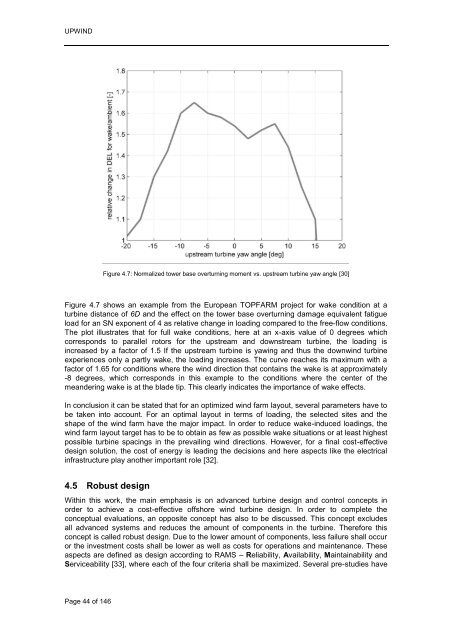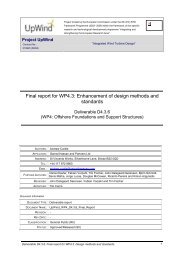Create successful ePaper yourself
Turn your PDF publications into a flip-book with our unique Google optimized e-Paper software.
UPWIND<br />
Page 44 of 146<br />
Figure 4.7: Normalized tower base overturning moment vs. upstream turbine yaw angle [30]<br />
Figure 4.7 shows an example from the European TOPFARM project for wake condition at a<br />
turbine distance of 6D and the effect on the tower base overturning damage equivalent fatigue<br />
load for an SN exponent of 4 as relative change in loading compared to the free-flow conditions.<br />
The plot illustrates that for full wake conditions, here at an x-axis value of 0 degrees which<br />
corresponds to parallel rotors for the upstream and downstream turbine, the loading is<br />
increased by a factor of 1.5 If the upstream turbine is yawing and thus the downwind turbine<br />
experiences only a partly wake, the loading increases. The curve reaches its maximum with a<br />
factor of 1.65 for conditions where the wind direction that contains the wake is at approximately<br />
-8 degrees, which corresponds in this example to the conditions where the center of the<br />
meandering wake is at the blade tip. This clearly indicates the importance of wake effects.<br />
In conclusion it can be stated that for an optimized wind farm layout, several parameters have to<br />
be taken into account. For an optimal layout in terms of loading, the selected sites and the<br />
shape of the wind farm have the major impact. In order to reduce wake-induced loadings, the<br />
wind farm layout target has to be to obtain as few as possible wake situations or at least highest<br />
possible turbine spacings in the prevailing wind directions. However, for a final cost-effective<br />
design solution, the cost of energy is leading the decisions and here aspects like the electrical<br />
infrastructure play another important role [32].<br />
4.5 Robust design<br />
Within this work, the main emphasis is on advanced turbine design and control concepts in<br />
order to achieve a cost-effective offshore wind turbine design. In order to complete the<br />
conceptual evaluations, an opposite concept has also to be discussed. This concept excludes<br />
all advanced systems and reduces the amount of components in the turbine. Therefore this<br />
concept is called robust design. Due to the lower amount of components, less failure shall occur<br />
or the investment costs shall be lower as well as costs for operations and maintenance. These<br />
aspects are defined as design according to RAMS – Reliability, Availability, Maintainability and<br />
Serviceability [33], where each of the four criteria shall be maximized. Several pre-studies have











